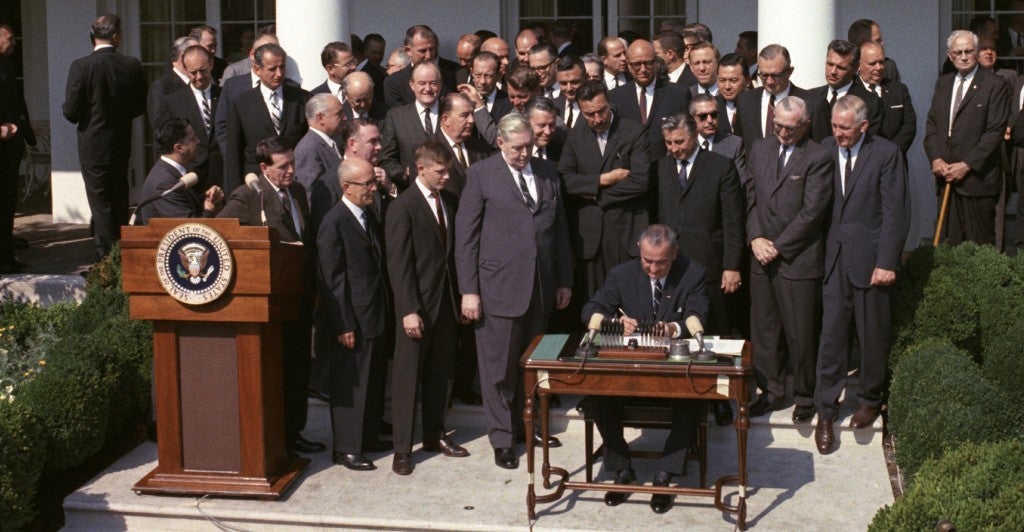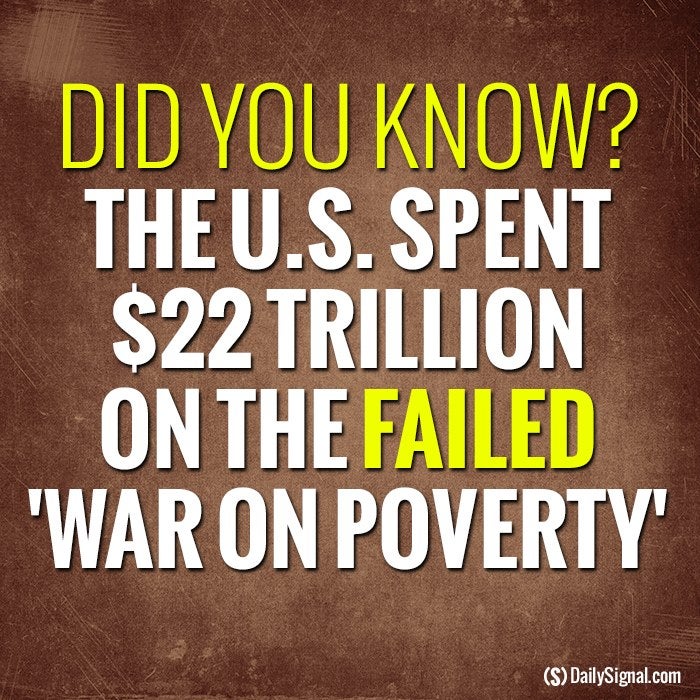It’s been 50 years now since the federal government launched its “War on Poverty.” But the numbers just released by the Census Bureau suggest we’re in a losing battle.
The poverty rate now stands at 14.5 percent. That’s a drop from the previous rate of 15 percent. But don’t celebrate too quickly. The new rate is almost exactly the poverty rate we had in 1967, only three years after President Lyndon Johnson announced his war.
To put it in further perspective: The poverty rate in 1950 was 32.2 percent. It dropped steadily throughout the ’50s, and had been nearly cut in half before the War on Poverty began. After that, the rate declined slightly, then leveled out.
More than 100 million — about one third of the U.S. population — receives aid from at least one welfare program.
That was $22 trillion ago. That’s right, trillion with a “t.” A 22 with 12 zeros behind it. To understand how much that is, if you laid a trillion $1 bills end to end, they would reach the sun. Now multiply that by 22. That’s enough for 11 round trips.
In short, it’s a lot of money. Yet the poverty rate is essentially the same as it was 50 years ago.
The federal government runs more than 80 means-tested welfare programs that provide cash, food, housing and medical care to low-income Americans. Federal and state spending on these programs last year was $943 billion (not counting Social Security, Medicare or unemployment insurance).
This money is going to a lot of people. More than 100 million — about one third of the U.S. population — receives aid from at least one welfare program. The average cost per recipient in 2013? $9,000. If converted into cash, current means-tested spending is five times what’s needed to eliminate all poverty in the United States.
So how can the poverty rate be practically the same? You have to understand two things.
One is that, incredibly, the Census Bureau counts almost none of the $943 billion in yearly welfare spending as family “income.” It acts as though that money doesn’t exist. And because the government counts a family as poor if its income falls below specified thresholds, a lot of people are being, in essence, mislabeled as poor.
That leads to the second thing we have to understand. When most people hear that a family is living in poverty, they naturally picture people suffering from significant material deprivation. They imagine people without enough food or clothing, or without a decent roof over their heads.
Sadly, of course, such conditions do exist for some Americans. But government surveys show that many of those officially designated as poor are surprisingly well-off.
Less than 2 percent are homeless, and only one in 10 live in mobile homes. The typical house or apartment of the poor is in good repair and uncrowded. Indeed, the typical “poor” family has air conditioning, cable or satellite TV, and a computer in the home. Forty percent have a wide-screen HDTV. Another 40 percent have Internet access.
So should we consider War on Poverty to be a success? Hardly. It was designed, according to Johnson, to increase self-sufficiency. Individuals and families who needed a hand up would get it, but the ultimate goal was to shrink the welfare rolls and transform the poor, Johnson said, from “tax-eaters” to “taxpayers.”
“Judged by that standard, the War on Poverty has been a colossal flop,” writes poverty expert Robert Rector of the Heritage Foundation. “The welfare state has undermined self-sufficiency by discouraging work and penalizing marriage.”
Fifty years ago, only 7 percent of children were born outside of marriage, which remains the single greatest weapon against child poverty. Today, it’s 41 percent.
Yet President Obama plans to spend $13 trillion over the next decade on welfare programs that discourage work and marriage.
It’s time to turn this around. According to Mr. Rector, able-bodied recipients of cash, food and housing should be required to work or prepare for work as condition of receiving aid. Welfare’s penalties against marriage should be reduced.
In short, it’s time to return to Johnson’s original vision to “replace their despair with opportunity.”
Originally appeared in the Washington Times.

